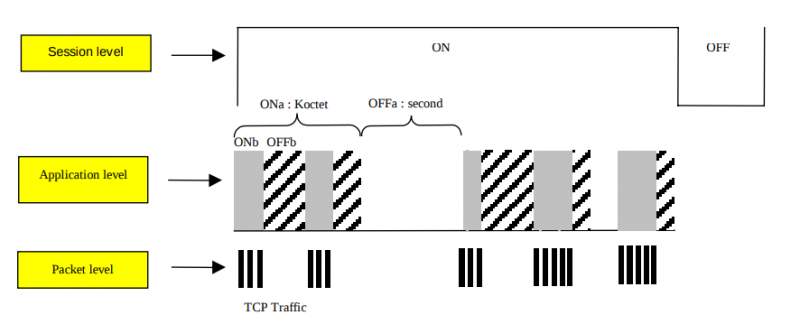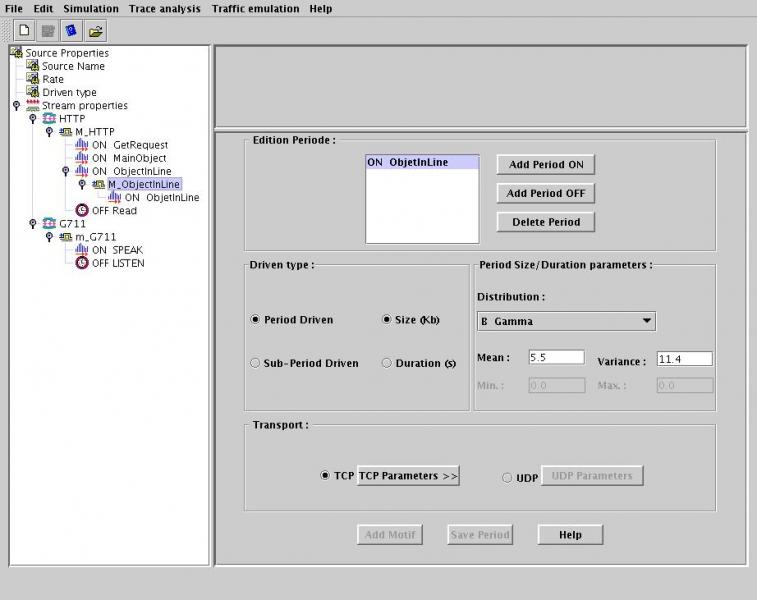Traffic source modeling
Statistical model of network traffic
The evolution of services offered by telecommunications networks (especially the Internet) has highlighted the need for Quality of Service (QoS) to meet the needs of the applications provided to customers.The lack of reliable modeling of Internet flows poses a challenge to estimating QoS. Operators and ISPs need simulation tools that integrate precise models, different flows involved in the traffic passing through the networks, in order to be able to estimate the quality of service and to size the networks in the optimal way. This modeling is confronted with the diversity of deployed applications and their bit rates. A source of traffic can be very simple with a constant bit rate (CBR), or an exponential random rate. On the other hand, a traffic source can produce bursts of packets that strongly influence network resources. The simulation of a source of traffic consists of finding a model that makes it possible to generate dates of creation of packets of a certain size according to the type of application. To arrive at this model, one seeks a general approach based on generic mathematical tools. In this approach, three levels are differentiated: Session, Application and Packet.
The behavior on the Application level depends on the application in question. The applications are very different in their needs. There are real-time applications that impose hard or soft time constraints to meet. Often these applications are associated with the UDP transport protocol, the unreliable transport protocol. The second category includes non-real-time applications that are generally of the data type, associated with the TCP transport protocol, the reliable transport protocol with acknowledgment. The purpose of this document is to present a summary of the main traffic patterns of the literature in order to design a general library of traffic sources that includes all the applications deployed on telecommunications networks: voice, video and data on fixed networks, mobile and wireless.
Nest Traffic Source Modeler (developped in 2005 with continuous maintenance) : I developed a statistical analysis tool to characterize traffic sources complex: packet size, inter-arrival packets, statistical distributions, packet patterns. Source Modeler developped in LAAS is currently offered by Qos Design. This software is aimed to build complex traffic sources for simulation or packet injection. It allows entering parameters for:
- User session Level: ON-OFF distributions …
- Application Level: composed by any number of streams.
- Streams: independent packet generating processes can be combined within the same source model.
- Stream synchronization: allows creating interstreams bursts, or simulating signaling packets in some applications.
- Packet Level: allows describing packet size distribution and transport protocols (UDP, TCP…).

Traffic behavior


Source properties editor and Packet size content
Traffic Log Analyzer, this module is aimed to analyze traffic logs, compute statistics, and find the best source model for simulation:
- Distribution fitting, combination of multiple distributions …
- Hurst, variance, correlations, short range and long range dependence models,
- EM algorithms …

Cumulative function from a sample
Statistical distribution of traffic sources in network simulation tools
F.CAMPS, E.THIBAULT, S.HARASSE
Manifestation avec acte : World Congress on Engineering and Computer Science (WCECS 2008)
Berkeley (U.C) (USA), 22-24 Octobre 2008, pp.740-743 , N° 08488